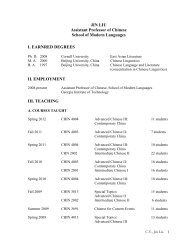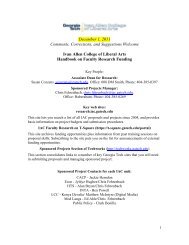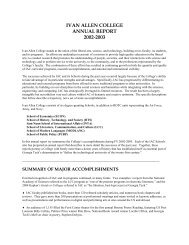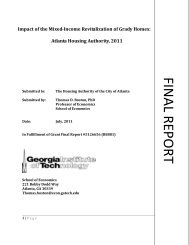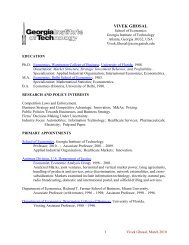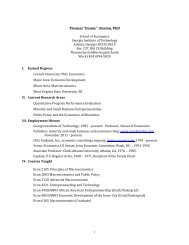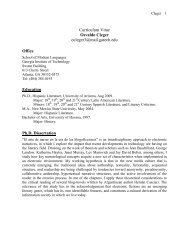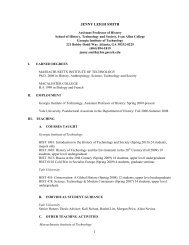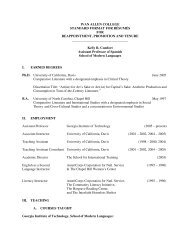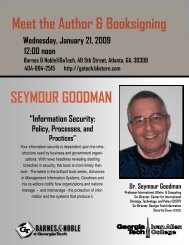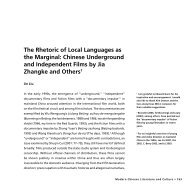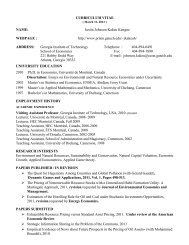MARGARET E. KOSAL ASSISTANT PROFESSOR SAM NUNN ...
MARGARET E. KOSAL ASSISTANT PROFESSOR SAM NUNN ...
MARGARET E. KOSAL ASSISTANT PROFESSOR SAM NUNN ...
Create successful ePaper yourself
Turn your PDF publications into a flip-book with our unique Google optimized e-Paper software.
<strong>MARGARET</strong> E. <strong>KOSAL</strong><br />
<strong>ASSISTANT</strong> <strong>PROFESSOR</strong><br />
<strong>SAM</strong> <strong>NUNN</strong> SCHOOL OF INTERNATIONAL AFFAIRS<br />
I. EARNED DEGREES<br />
Ph.D. Chemistry, 2001<br />
University of Illinois at Urbana-Champaign<br />
Dissertation: Porphyrin Network Materials: Chemical Exploration in the Supramolecular Solid-State<br />
B.S. Chemistry, with Honors, 1995<br />
University of Southern California, Los Angeles CA<br />
II.<br />
EMPLOYMENT<br />
Assistant Professor<br />
Sam Nunn School of International Affairs<br />
Georgia Institute of Technology, Atlanta GA<br />
August 2008 - present<br />
Visiting Assistant Professor<br />
Sam Nunn School of International Affairs<br />
Georgia Institute of Technology, Atlanta GA<br />
August 2007 - July 2008<br />
Science & Technology Advisor<br />
Office of the Deputy Assistant for Chemical and Biological Defense and Chemical Demilitarization Programs<br />
Office of Secretary of Defense<br />
Department of Defense, Washington, DC<br />
September 2005 - August 2007<br />
Science Fellow<br />
Center for International Security and Cooperation, Stanford CA<br />
Institute for International Studies<br />
Stanford University<br />
September 2004 - August 2005<br />
August 2003 - 2004<br />
Adjunct Professor<br />
Post-doctoral Fellow<br />
Center for Nonproliferation Studies, Monterey CA<br />
Monterey Institute of International Studies<br />
Visiting Scientist<br />
School of Chemical Sciences<br />
University of Illinois at Urbana-Champaign, Urbana IL<br />
June - August 2003<br />
Co-founder and Senior Scientist<br />
ChemSensing, Inc., Urbana IL<br />
December 2000 - May 2003<br />
Graduate Research Assistant<br />
School of Chemical Sciences<br />
University of Illinois at Urbana-Champaign, Urbana IL<br />
August 1995 - May 2001
Margaret E. Kosal, PhD<br />
III.<br />
TEACHING<br />
A. COURSES<br />
INTA 2040: “Science, Technology, and International Affairs” Spring 2008 (91 students), Fall<br />
2008 (38 students), Spring 2009 (93 students), Fall 2009 (91 students), Spring 2010 (82 students)<br />
– INTA 4803-K/8803-K: “Emerging Technologies and Security” Fall 2007 (4 students)<br />
– INTA 4500-B: “Counterinsurgency and Small Wars” Fall 2010 (18 students)<br />
– INTA 8803-K: “Counterinsurgency and Small Wars” Fall 2009 (17 graduate students)<br />
– INTA 8803-K: “Problems of Proliferation” Spring 2010 (5 graduate students)<br />
– INTA 8803-K: “21 st Century Deterrence” Fall 2010 (8 graduate students)<br />
B. INDIVIDUAL STUDENT GUIDANCE<br />
Postdoctoral:<br />
– Dr. KJ Dennison, Fall 2007 - Fall 2008<br />
Ph.D.:<br />
– Mr. Jonathan Huang, “Cognitive Sciences, Theory, and Institutions” Spring 2008-present,<br />
qualifying exams passed February 2010<br />
M.S.<br />
– Mr. Christopher Vucich, “Terrorism and Insurgency in Africa” Spring 2010, Summer 2010, & Fall<br />
2010. Student presented supervised work on “Al-Qa’eda & WMD: AQIM Plague Breakout and<br />
the UK Ricin Plot,” at the 2010 Defense Threat Reduction Agency (DTRA) Basic Research<br />
Technical Review Conference 18 August 2010, Springfield, VA.<br />
– Mr. Bryan Murphy, “Law Enforcement and Governance: the Role for Counterinsurgency Theory”<br />
Summer 2010<br />
– Ms. Shawn Finnell, “Radical Islam & WMD Discourse” Spring 2010 & Summer 2010. Student<br />
presented supervised work on “Al Qa’eda & WMD: Analysis of Chlorine Bombs in Iraq and the<br />
“Mubtakkar” Plot,” at the 2010 Defense Threat Reduction Agency (DTRA) Basic Research<br />
Technical Review Conference 18 August 2010, Springfield, VA.<br />
– Ms. Jessica Gibson, “Bioterrorism Preparedness Training and Assessment Exercises for Local<br />
Public Health Agencies,” Fall 2008<br />
Undergraduates:<br />
– Mr. Wesley Griggs, “Iran and WMD Proliferation” Fall 2010<br />
– Ms. Sapphire Liu, “Security and Gaming” Fall 2010<br />
– Mr. Jared Fry, “WMD in Gaming” Spring 2010, Summer 2010, Fall 2010<br />
Presidential Undergraduate Research Award (PURA) recipient for Spring 2011<br />
– Ms. Lucia Bird, “Hamas, Hezbollah, and WMD’s” Fall 2010<br />
– Ms. Sarah Grace Parr, “Nuclear Proliferation & International Conflict” Fall 2010<br />
– Mr. RJ Paulisick, “Nano and Nuclear Technology: The Implications of an Emerging Technology<br />
on Nuclear Energy and Nuclear Weapons” Fall 2010<br />
– Mr. Graham Sweeney, “Nanotechnology and Security: Russia” Summer 2010 & Fall 2010<br />
– Ms. Patti Murphy, “The Security Implications of Advanced Neuroscience, Pharmaceuticals, and<br />
the Cognitive Sciences” Summer 2010 & Fall 2010<br />
– Mr. Vincent Chan, “Nanotechnology and Security: Strategic Significance of Nanotechnology in<br />
China” Summer 2010<br />
– Mr. Adam Weiss, “Nanotechnology Policy and Security: Israel” Spring 2010<br />
– Ms. Katherine Lange “Deterring Bioterrorism: Re-Emerging Infectious Disease and Deterrence<br />
Theory” Summer 2009, Fall 2009, & Spring 2010<br />
Presidential Undergraduate Research Award (PURA) recipient & outstanding poster presentation<br />
awardee from the Ivan Allen College at the Georgia Tech 2010 Undergraduate Research<br />
Symposium<br />
– Ms. Amira Mouna, “Bionanotechnology and Security” Spring 2009, Summer 2009, & Fall 2009.<br />
SAIC Undergraduate research award recipient<br />
2
Margaret E. Kosal, PhD<br />
– Mr. Ted Danowitz, “Nanotechnology and Security: Strategic Significance of Nanotechnology in<br />
China” Summer 2009 & Fall 2009<br />
Outstanding oral presentation awardee from the Ivan Allen College at the Georgia Tech 2010<br />
Undergraduate Research Symposium<br />
– Ms. Katherine Murphy, “Regulation of Nanotechnology in Europe and US” Fall 2009<br />
– Mr. Mitchell Watkins, “Al Qa’eda and Unconventional Weapons” Summer 2009 & Fall 2009<br />
– Ms. Rasha Nahab, “Biotechnology Policy and the Life Sciences” Summer 2009<br />
– Ms. Ana Terron, “Deterring Bioterrorism: Re-Emerging Infectious Disease and Deterrence<br />
Theory” Spring 2009<br />
– Ms. Nikita Basandra, “Bionanotechnology and Security: Strategic Significance of<br />
Bionanotechnology in Iran” Spring 2009<br />
– Mr. Kemp Anderson “Al Qa’eda and Unconventional Weapons” Spring 2009<br />
– Ms. Sophia Ahmed, “Pakistan & the Role of International Institutions for Security” Fall 2008 &<br />
Spring 2009<br />
– Ms. Katherine Ruth Landers, “Emerging Biotechnologies and International Security” Fall 2008<br />
C. OTHER TEACHING ACTIVITIES<br />
Newly Developed Courses:<br />
– INTA 8803-K: “Deterrence in the 21 st Century” Fall 2010<br />
– INTA 8803-K: “Counterinsurgency and Small Wars” Fall 2009<br />
– INTA 4803-K/8803-K: “Emerging Technologies and Security” Fall 2007<br />
– Developed and lead “Workshop on Technology, Policy, and Entrepreneurship,” Materials Science<br />
and Engineering Department Summer Research Experience for Undergrads (REU), July 2009,<br />
July 2010<br />
Redesigned course:<br />
– INTA 3102/8803: “Problems of Proliferation” Spring 2010<br />
Visiting Professor, IAEN, Quito Ecuador:<br />
– “Threats to Security, Technology, and Information Society,” Master’s program on Security and<br />
Defense, Instituto Altos Estudios Nacionales (IAEN, National Institute of Advanced Studies),<br />
Quito Ecuador, Summer 2010 (36 students)<br />
IV.<br />
SCHOLARLY ACCOMPLISHMENTS<br />
A. PUBLISHED BOOKS AND PARTS OF BOOKS<br />
A1. BOOKS<br />
Kosal, M.E, Nanotechnology for Chemical and Biological Defense, Springer Academic Publishers:<br />
New York, June 2009, 179 pages.<br />
A2. REFEREED BOOK CHAPTERS<br />
Kosal, M.E., “Nanotechnology for Chemical, Biological, and Radiological Detection and Protection,”<br />
in Applications of Nanoscale Science and Nanotechnology to Food Systems, Chen, H., ed. Wiley-<br />
Blackwell: New York, forthcoming 2011 (30 pages).<br />
Kosal, M.E., “Scenarios for Anticipating Emerging Technology: Nanotechnology for Chemical and<br />
Biological Defense 2030 Workshop and Study,” in The Yearbook of Nanotechnology in Society -<br />
Volume 1: Presenting Futures, Fisher, E.; Selin, C.; Wetmore, J. eds., Springer Academic Publishers:<br />
New York, 2008, 157-173.<br />
Kosal, M.E., “Near Term Threats of Chemical Weapons Terrorism,” in Globalization and WMD<br />
Proliferation: Terrorism, Transnational Networks and International Security, Russell, J.; Wirtz, J.<br />
Routledge, 2007, 63-78.<br />
3
Margaret E. Kosal, PhD<br />
Kosal, M.E. “Chemical Weapons Destruction and the Public Response,” in Towards the Elimination<br />
of the Chemical Weapons, Haru, E. and Thakur, R. eds., UN University Press, Netherlands, 2006,<br />
118-149 – 2 citations<br />
Chou, J-H.; Kosal, M.E.; Nalwa, H.S.; Rakow, N.A; Suslick, K.S. “Applications of Porphyrins and<br />
Metalloporphyrins to Materials Chemistry,” in The Porphyrin Handbook, Kadish, K.; Smith, K.;<br />
Guilard, R., eds.; Academic Press: New York, 2000, 6, pp. 41-131 – 73 citations.<br />
A3. OTHER PARTS OF BOOKS<br />
Kosal, M.E. articles on “Nano-Biotechnology,” (8 pages) for the Encyclopedia of Bioterrorism<br />
Defense, Zilinskas, R.A.; Katz, R/ eds.; Revised and updated chapters on “Anti-Material Agents” (7<br />
pages) and “Biological Simulants,” (4 pages) Wiley: New York, 2011.<br />
Kosal, M.E, articles on Department of Defense; Security; Ethical Issues of Nano-Weapons; and Iran<br />
for Encyclopedia of Nanoscience and Society, edited by David Guston, Sage Publishers: Thousand<br />
Oaks CA, 2010 (total 34 pages).<br />
Kosal, M.E, Stulberg, A. article on Russia, Encyclopedia of Nanoscience and Society, edited by<br />
David Guston, Sage Publishers: Thousand Oaks CA, 2010 (6 pages).<br />
Kosal, M.E., “Chemical Terrorism,” in Weapons of Mass Destruction and Terrorism, Howard, R.D.<br />
and Forest, J.F., eds. McGrawHill/Contemporary Learning Series, Inc.: New York, 2007, 581-595.<br />
Kosal, M.E. articles on “Biological Simulants” (6 pages) and “Anti-material Agents,” (3 pages) for<br />
the Encyclopedia of Bioterrorism Defense, Wiley: New York, June 2005.<br />
Kosal, M.E., “Bioweapons Detectors,” in Biological Weapons, Naff, C.F., ed., Greenhaven Press:<br />
New Haven, 2006, 109-117.<br />
Cassagrande, R.; Kosal, M.E. “Detection of Bioterrorist Agents,” (9 pages) Encyclopedia of<br />
Bioterrorism Defense, Zilinskas, R.A.; Pilch, R., eds., Wiley: New York, June 2005.<br />
B. REFEREED PUBLICATIONS<br />
B1. REFEREED JOURNAL PUBLICATIONS<br />
Kosal, M.E. “The Contested Commons of WMD Terrorism and Radical Islam,” at review at Studies<br />
in Conflict and Terrorism.<br />
Kosal, ME.; Wagner, J.E.; Massoomi, F. “Gap Analysis and Recommendations to Improve<br />
Preparedness for a Chemical Attack Involving Organophosphate Compounds,” at review at Critical<br />
Care.<br />
Suslick, K.S.; Kosal, ME.; et al. “Seeing Smells: Development of an Optoelectronic Nose,” Química<br />
Nova, 2007, 30, 677-681 – 15 citations.<br />
Kosal, M.E. “Terrorism Targeting Industrial Chemical Facilities: Strategic Motivations and the<br />
Implications for U.S. Security,” Studies in Conflict and Terrorism, 2006, 29, 719-751 – 3 citations.<br />
Kosal, M.E., “Near Term Threats of Chemical Weapons Terrorism,” Strategic Insights, 2006, 5, 56-<br />
70 – 2 citations.<br />
Kosal, M.E.; Anderson, D.A. “An Unaddressed Issue of Agricultural Terrorism – A Case Study on<br />
Feed Security,” Journal of Animal Science, 2004, 82, 3394-3400 – 14 citations.<br />
Suslick, K.S.; Kosal, M.E.; et al. “Microporous Porphyrin Solids,” Accounts of Chemical Research,<br />
2005, 38, 283-321 – 150 citations.<br />
Kosal, M.E.; Chou, J-H.; Suslick, K.S. “A Calcium-Bridged Porphyrin Network,” J. Porphyrins and<br />
Phthalocyanines, 2002, 6, 377-383 – 17 citations.<br />
Kosal, M.E.; Chou, J-H.; Wilson, S.R.; Suslick, K.S. “A Functional Zeolite Analogue Assembled<br />
From Metalloporphyrins,” Nature Materials, 2002, 1, 118-124 – 174 citations.<br />
4
Margaret E. Kosal, PhD<br />
Suslick, K.S.; Rakow, N.A.; Kosal, M.E.; Chou, J-H. “The Materials Chemistry of Porphyrins and<br />
Metalloporphyrins,” J. Porphyrins and Phthalocyanines, 2000, 4, 407-434 – 35 citations.<br />
Kosal; M.E.; Suslick, K.S. “Microporous Porphyrin and Metalloporphyrin Materials,” J. Solid State<br />
Chemistry, 2000, 152, 87-101 – 43 citations.<br />
Brunner, R.S.; Kosal, M.E.; Suslick, K.S.; Lamche, R.; Marti, O.; White, J.O. “Near-Field Scanning<br />
Optical Microscopy (NSOM) of Zinc-Porphyrin Crystals,” Ultramicroscopy, 2000, 84, 149-155 – 3<br />
citations.<br />
B2. OTHER REFEREED PUBLICATIONS<br />
Suslick, K.S.; Kosal, M.E.; McNamara, W.B.; Sen, A.; Rakow, N.A. “ChemSensing: A Colorimetric<br />
Array Detector,” 9 th International Symposium on Olfaction and Electronic Nose (ISOEN ’02)<br />
Proceedings, D’Amico A.; DiNatale, C, eds., IEEE: Baltimore, 2003, pp. 46-52.<br />
Suslick, K.S.; Kosal, M.E.; Rakow, N.A.; Sen, A. “Smell-Seeing: A New Approach to Artificial<br />
Olfaction,” Eurodeur-Airodeur 2001 Proceedings, Paris 2002.<br />
C. OTHER PUBLICATIONS<br />
Kosal, M.E. “The Security Implications of Nanotechnology,” Bulletin of Atomic Scientists,<br />
July/August 2010, 66, 58-69.<br />
Kosal, M.E. “Strategic Approaches to Regulating Biosecurity Risks of Nanotechnology by the<br />
European Union,” Post-EUCE Travel Grant Research Report, June 2010 (12 pages).<br />
Kosal, M.E. “Probing the Strategic Significance of Nanotechnology in Iran,” paper presented at the<br />
International Studies Association (ISA) Annual Meeting, 17 February 2010, New Orleans LA (16<br />
pages).<br />
Kosal, M.E. “Bioterrorism Deterrence: Polio and the Threat of Biological Terrorism,” paper<br />
presented at the International Studies Association (ISA) Annual Meeting, 19 February 2010, New<br />
Orleans LA (23 pages).<br />
M.E. Kosal, “Bionanotechnology and Iran” paper presented at the 2009 Atlanta Conference on<br />
Science and Innovation Policy, Atlanta, GA, 3 October 2009 (9 pages).<br />
Kosal, M.E., “Bioterrorism Deterrence: the Role of Public Health in Security,” paper presented at the<br />
2009 Atlanta Conference on Science and Innovation Policy, Atlanta, GA, 2 October 2009 (10 pages).<br />
Kosal, M.E. “Bionanotechnology and Security: Is Small Scary?” paper presented at the International<br />
Conference on Emerging and Disruptive Technologies, Singapore, 14 September 2009 (16 pages).<br />
Kosal, M.E. and Cole, K., invited review of The Making of the Digital World by J.K. Rennstitch,<br />
Palgrave McMillan, International Studies Review, June 2009, 11, 365-367.<br />
Kosal, M.E., invited review of Chemical Warfare Agents: Chemistry, Pharmacology, Toxicology, and<br />
Therapeutics, by James A. Romano, Jr., Brian J. Lukey, and Harry Salem (editors), CRC Taylor &<br />
Francis, International Journal of Toxicology, March/April 2009, 28, 132-135.<br />
Kosal, M.E. “Will There be an AQ Khan of Nanotechnology? Anticipating Biological Proliferation<br />
Threats from a Revolutionary Technology,” paper presented at the International Studies Association<br />
(ISA) Annual Meeting, 17 February 2009, New York, NY (23 pages).<br />
Kosal, M.E., “Unified Field Theory of Proliferation: Toward a Meta-Theory Predicting Nuclear<br />
Expansion,” white paper prepared as part of SAIC-funded project, January 2009 (25 pages).<br />
Kosal M.E. and Dennison, K.J. Toward a Strategic Vision in Basic Sciences for Chemical and<br />
Biological Defense, Report from the Symposium, December 2008 (67 pages).<br />
Kosal, M.E., “Chemical Terrorism: Review of US Policies to Implement Recommendations of the 9-<br />
11 Commission” September 2008 (30 pages).<br />
5
Margaret E. Kosal, PhD<br />
Kosal, M.E. review of Bioviolence: Preventing Biological Terror and Crime by B. Kellman,<br />
Cambridge University Press, Review of Policy Research (RPR), September 2008, 25, 492-495.<br />
Kosal, M.E. and Huang, J.Y. “The Security Implications of Cognitive Science Research,” Bulletin of<br />
Atomic Scientists, July 2008 (7 pages).<br />
Kosal, M.E. “Assessing the Potential International Security Threats of Nanotechnology,” paper<br />
presented at the Atlanta Conference on Science, Technology, and Innovation Policy, 19 October<br />
2007, Atlanta GA (19 pages).<br />
Kosal, M.E. “Art or Bioterrorism? Implications of the Kurtz Case for Research Science and for<br />
Limiting Terrorist Threats,” INESAP Bulletin, December 2004, 24, 85-91.<br />
Kosal, M.E. “Is Small Scary? Nanotechnology Research in an Age of Terrorism,” Bulletin of Atomic<br />
Scientists, September/October 2004, 60, 38-64.<br />
Baker, M.; Kosal, M.E. “Osmium Tetroxide – A New Chemical Terrorism Weapon?” CNS Research<br />
Story, 13 April 2004.<br />
Kosal, M.E. “The Basics of Chemical and Biological Weapons Detectors,” CNS Research Story, 24<br />
November 2003.<br />
Kosal, M.E. “The U.S. Response to WMD Beyond Iraq: the First CWC Review Conference and the<br />
NPT Preparatory Conference,” The Public I, June 2003, 9.<br />
Bremer Mærli, M.; Kosal, M.E. “A More Troubling Nuclear Threat: Unsecured Fissile Material,” The<br />
Public I, January 2003, 1, 16.<br />
Kosal, M.E.; Brunner, R.S.; Suslick, K.S.; White, J.O. “Unusual Fluorescence Behavior of Zinc<br />
Porphyrin Crystals as Characterized by NSOM,” Frederick Seitz Materials Research Laboratory<br />
Department of Energy (DOE) Program Review (cover), Urbana IL, June 1998, 11-14.<br />
D. PRESENTATIONS<br />
“The Role of Discourse in the Contested Commons of Radical Islam & WMD Terrorism” and “WMD<br />
in Gaming: The Implications of Virtual Biological, Chemical, and Nuclear Weapons For Training,<br />
Education, and Preparedness” to be given at International Studies Association (ISA) Annual Meeting,<br />
16-19 March 2011, Montreal. Discussant, panel on “Remote Control? The Ethics of Distance in<br />
Military Conflicts” and panel on “Analyzing the Foreign Policy of Nonproliferation.” Chair panel<br />
on “Communicating in Crisis and Conflict” and panel on “Danger and Diplomacy on the Korean<br />
Peninsula.”<br />
“The Role of Discourse in the Contested Common of Radical Islam & WMD Terrorism,”<br />
International Security Studies of ISA and the International Security and Arms Control Section of<br />
APSA annual meeting, 14-16 October, Providence, RI. Chair, panel, on Religion, Diplomacy, and the<br />
Use of Force.<br />
“Will There be an AQ Khan of Nanotechnology? Anticipating Biological Proliferation Threats from<br />
a Revolutionary Technology,” The Society for the Study of Nanoscience and Emerging Technologies<br />
(S.NET), 29 September - 2 October 2010, Darmstadt, Germany. Chair & discussant, panel on<br />
Emerging Assessments.<br />
Invited speaker “Nanotechnology for Biological Defense: Detection, Protection, Decontamination,<br />
and Medical Countermeasures,” United Nations experts’ workshop on Synthetic Biology and<br />
Nanobiotechnology Risks and Responses Assessment, 28 June 2010, Palais des Nations, Geneva,<br />
Switzerland.<br />
Keynote speaker “Nanotechnology and International Security,” First International Nanotechnology<br />
Congress, 11 June 2010, Quito Ecuador.<br />
Invited Speaker “International Policy and Governance Challenges of Nanotechnology and Emerging<br />
Technologies,” Bilkent University, 17 May 2010, Ankara Turkey.<br />
6
Margaret E. Kosal, PhD<br />
“Nanotechnology for Detection of and Medical Countermeasures Against Biological Warfare<br />
Agents: Policy and Programmatics,” 2nd Annual Georgia Nanotechnology in Infectious Diseases<br />
Symposium, Emory University, 1 April 2010, Atlanta GA.<br />
Keynote speaker “Global Nanotechnology Threats: Science, Technology, and Policy for Reducing<br />
the Threat of Proliferation, Crime, and Terrorism,” United Nations Interregional Crime and Justice<br />
Research Institute (UNICRI) experts workshop on Synthetic Biology and Nanobiotechnology Risks<br />
and Responses, 24-25 March 2010, Turin, Italy.<br />
“Strategic Significance of Emerging Technologies in Asia,” Director of National Intelligence Centers<br />
of Academic Excellence Colloquium on National Security, 24 February 2010, Atlanta GA.<br />
“Probing the Strategic Significance of Nanotechnology in Iran,” and “Bioterrorism Deterrence: Polio<br />
and the Threat of Biological Terrorism” International Studies Association (ISA) Annual Meeting, 16-<br />
20 February 2010, New Orleans LA. Discussant, panel on Space Weapons.<br />
Keynote Speaker “Nanotechnology and Defense,” Workshop on Emerging Technologies, Military<br />
Operations, and National Security, the Consortium on Emerging Technologies, Military Operations,<br />
and National Security (CETMONS), 5-6 February 2010. Phoenix AZ.<br />
Invited Speaker “Nanotechnology for Chemical and Biological Defense: Policy, Programs, and<br />
Threat Anticipation,” Center for Nanotechnology in Society and Consortium for Science, Policy &<br />
Outcomes, Arizona State University, 4 February 2010, Tempe AZ.<br />
Invited Speaker “Nanotechnology – Emerging Applications for the Protection against Chemical<br />
Warfare Agents,” Organisation for the Prohibition of Chemical Weapons (OPCW), 9 November<br />
2009, The Hague, The Netherlands.<br />
“Nanotechnology for Chemical and Biological Defense: Policy, Programmatics, and Threat<br />
Anticipation,” Nano@Tech Seminar Series, Marcus Nanotechnology Building, 27 October 2009.<br />
Invited Speaker “Nanotechnology for Chemical and Biological Defense” 3 rd Army/US Army Central,<br />
23 October 2009, Ft McPherson GA.<br />
Invited Speaker “Bionanotechnology and Security: Is Small Scary?” International Conference on<br />
Emerging and Disruptive Technologies, 14-15 September 2009, Singapore.<br />
“Bionanotechnology and Iran,” Atlanta Conference on Science, Technology, and Innovation Policy, 3<br />
October 2009, Atlanta GA.<br />
“Bioterrorism Deterrence: the Role of Public Health in Security,” Atlanta Conference on Science,<br />
Technology, and Innovation Policy, 2 October 2009, Atlanta GA.<br />
Keynote Speaker “Deterrence, Policy, and Strategic Security Implications of Synthetic Smallpox,” at<br />
the Over the Horizon Workshop on Synthetic Smallpox, 29-30 June 2009, Alexandria VA.<br />
“Predicting Nuclear Proliferation: Theory, Policy, and Role for Engineers,” Nuclear and Radiological<br />
Engineering Symposia, Woodruff School of Engineering, Georgia Institute of Technology, 23 April<br />
2009, Atlanta GA.<br />
Invited Speaker “Nanotechnology and Security: Dual Use Issues in Emerging Science” American<br />
Chemical Society, International Programs Symposium, 9-11 April 2009, Washington, D.C.<br />
“Predicting Nuclear Proliferation: Toward a Unified Field Theory” Transforming the Nuclear<br />
Weapons Complex (NWC) to Address 21 st Century Security Threats Forum, Georgia Institute of<br />
Technology, 30 March 2009, Atlanta GA.<br />
Invited Speaker “Nanotechnology for Revolutionary Chemical and Biological Defense and<br />
Homeland Security,” Science for the Good: the R&D Agenda for the New Administration and<br />
Congress, National Bureau of Economic Research (NBER), 2 March 2009, Washington, D.C.<br />
7
Margaret E. Kosal, PhD<br />
“Will There be an AQ Khan of Nanotechnology? Anticipating Biological Proliferation Threats from a<br />
Revolutionary Technology,” International Studies Association (ISA) Annual Meeting, 15-18<br />
February 2009, New York, NY. Discussant, panel on The Politics of High Technology. Discussant,<br />
panel on Cyber-Terrorism, National Security, and International Communication.<br />
“Emerging Chemical and Biological Terrorism Threats,” Chemical & Biological Terrorism Defense<br />
Gordon Research Conference (GRC), 18-23 January 2009, Galveston TX.<br />
Invited Speaker “Scientific & Technology Challenges to Realize Revolutionary Breakthroughs in<br />
Nanotechnology” National Intelligence Council (NIC), 17 November 2008, McLean VA.<br />
Invited Speaker “Emerging Technology, Terrorism, and US Defense” National Security<br />
Agency/Central Security Service, 7 November 2008, Fort Gordon GA.<br />
Invited Speaker “Al Qa’eda and Unconventional Weapons” Global Futures Forum, Department of<br />
National Security Affairs, Naval Postgraduate School, 24 September 2008, Monterey CA.<br />
Briefing staff of the Congressionally-chartered Commission on the Prevention of WMD<br />
Proliferation and Terrorism on reducing the threat from chemical and biological agents from (a)<br />
traditional and improvised chemical proliferation and terrorism; (b) traditional and geneticallyengineered<br />
biological proliferation and terrorism; (c) the need for the USG to anticipate threat and<br />
risks from emerging technologies, including synthetic genomics and bio-nanotechnology; and (d)<br />
reducing the motivation to pursue WMD terrorism, 5 September 2008, Arlington VA.<br />
Invited Speaker “Chemical and Biological Weapons: Proliferation Issues and Threats” Summer<br />
Nonproliferation Institute’s “Preparing the Next Generation for Teaching, Research, and Public<br />
Service in Nonproliferation Policy” at the University of Georgia, 11 August 2008 Athens, GA.<br />
Invited Speaker, “Will There Be an AQ Khan of Nanotechnology? Considering the International<br />
Security Implications of an Emerging Science” Conference on Science and Global Security,<br />
Massachusetts Institute of Technology, 24 July 2008, Boston, MA.<br />
Invited Speaker “The Future of WMD,” at “Johnny Appleseed IV” Combating WMD for Military<br />
Educators, USAF Counterproliferation Center, 25 July 2008, Atlanta, GA.<br />
Invited Speaker “Al Qa’eda and Unconventional Weapons,” Tomorrow’s Proliferation Pathways:<br />
Weak States, Rogues, and Non-States, School of Policy and International Affairs, University of<br />
Maine, 17-18 July 2008, Belfast ME.<br />
Plenary Speaker on “Nanotechnology for Biochemical Sensors” at Government Microelectronics and<br />
Critical Technology (GOMACTech) Conference, 17 March 2008, Las Vegas, NV.<br />
“Terrorism Targeting Industrial Chemical Facilities: Strategic Motivations and Implications for U.S.<br />
Security,” School of Public and International Affairs, George Mason University, 26 November 2007,<br />
Fairfax VA.<br />
“The Shifting Faces of Chemical Weapons: Improvised Chemical Terrorism,” CISTP Colloquium on<br />
Chemical and Biological Weapons, 6 November 2007, Atlanta GA.<br />
“Weapons of Mass Destruction: Science and Technology to Respond to Global Proliferation Threats,”<br />
INTA Undergrad Students Organization (IASO), 11 October 2007, Atlanta GA.<br />
Invited Speaker “Emerging Technologies and Future Proliferation Threats in a Globalized World,”<br />
Arms Control, Disarmament and International Security (ACDIS) Program and Center for Nanoscale<br />
Science and Technology, University of Illinois at Urbana-Champaign, 25 October 2007, Champaign,<br />
IL.<br />
“Assessing the Potential International Security Threats of Nanotechnology,” Atlanta Conference on<br />
Science, Technology, and Innovation Policy, 19 October 2007, Atlanta GA.<br />
“Department of Defense Chemical and Biological Defense Program,” Joint Senior Leaders Course<br />
(O-5 through General Officers and Senior Civilians), 27 July 2007, Fort Leonard Wood MO.<br />
Invitation to speak on Threats of Chemical and Biological Terrorism at the CBRN/Terrorism Threat<br />
Convergence Project Workshop, Center for Asymmetric Threat Studies (CATS), Swedish National<br />
8
Margaret E. Kosal, PhD<br />
Defence College, 21-22 August 2007, Stockholm Sweden. Declined invitation (all expenses covered)<br />
due to start of classes at Georgia Tech.<br />
“Nanotechnology for Chemical and Biological Defense 2030: Strategic Research Directions,”<br />
Transformational Countermeasures Technology Initiative Kick-Off Meeting, 12 July 2007, Arlington<br />
VA.<br />
Plenary Speaker on “The DoD Nanotechnology for Chemical and Biological Defense 2030<br />
Workshop and Study – Results and Recommendations,” Nanoelectronic Devices for Defense and<br />
Security Symposia, 21 June 2007, Arlington VA.<br />
“DoD Chemical and Biological Defense Program Nanotechnology Initiative,” Emerging<br />
Contaminants Nanotechnology Forum, 14 June 2007, Arlington, VA.<br />
Invited Speaker “Will There Be an A.Q. Khan of Nanotechnology?” National Science Foundation<br />
(NSF) and National Security Agency (NSA) Symposia on Biosecurity and Training for the Federal<br />
Workforce, 8 May 2007, Baltimore MD.<br />
Invited Speaker “Bionanotechnology Threat Assessment,” Director of National Intelligence (DNI)<br />
Biological Sciences Experts Group (BSEG), 25 April 2007, Washington, D.C.<br />
Invited Speaker “Weapons of Mass Destruction: Science & Technology to Respond to Global<br />
Proliferation Threats” and “From Scientist to International Security (aka from beakers to bombs),”<br />
Ripon College, 26-27 April 2007, Ripon WI.<br />
“Science and Technology Initiatives in Nanotechnology within the Defense Department’s Chemical<br />
and Biological Defense Program,” National Academy of Sciences (NAS) Sackler Colloquium on<br />
Nanomaterials in Biology and Medicine: Promises and Perils, 10 April 2007, Washington, D.C.<br />
Keynote Speaker and Idea to Product® (I2P) Judge, “Transformational Science for Defense,”<br />
NanoNexus Conference and Competition, Oak Ridge National Laboratory, 3 April 2007, Oak Ridge<br />
TN.<br />
“Innovations Technology for Nonproliferation and Arms Control Through Nanotechnology,”<br />
Nonproliferation and Arms Control Technology Working Group (NPAC TWG) Conference “New<br />
Proliferation Challenges,” 28 March 2007, McLean VA.<br />
Invited Speaker “Biosecurity and Nanotechnology” DC Biosecurity Group, sponsored by the<br />
American Association for the Advancement of Science (AAAS) Center of Science, Technology, and<br />
Security Policy (CSTSP), 1 March 2007, Washington D.C.<br />
“Responding to the New Chemical and Biological Weapons Threats,” US-UK Joint Venture<br />
Operations Group (JVOG), February 2007, Arlington VA.<br />
“Will There Be an A.Q. Khan of Nanotechnology?” International Security Studies Section (ISSS) of<br />
International Studies Association and International Security and Arms Control section (ISAC) of<br />
American Political Science Association Annual Conference, 27 October 2006, Tucson AZ.<br />
“Revolutionary Innovation in Chemical and Biological Defense,” 7th Targeted Nanodelivery:<br />
Enabling Targeted Therapies and Non-Invasive Imaging Conference, 13 October 2006, Baltimore<br />
MD.<br />
Bovay Lecture on History and Ethics in Engineering, “Security and the Very Small,” School of<br />
Electrical Engineering and Computer Science and the Peace Studies Program, Cornell University, 11<br />
October 2006.<br />
Invited Speaker “Is Small Scary? Nanotechnology and National Defense,” Terrorism, Transnational<br />
Networks and WMD Proliferation, Center for Contemporary Conflict, Naval Postgraduate School,<br />
25-27 July 2006, Monterey CA.<br />
“Nanobiotechnology for Defense,” The Future of Nano-Bio Technology: Imagine the Possibilities,<br />
NVTC Nanotechnology & BioMedTech Committees, 14 February 2006, McLean VA.<br />
9
Margaret E. Kosal, PhD<br />
Invited Speaker “Chemical Weapons Terrorism: Near-Term Threats and Responses,” Globalization<br />
and WMD Proliferation Networks, Center for Contemporary Conflict, Naval Postgraduate School,<br />
29-30 June 2005, Monterey CA.<br />
“WMD Terrorism Threat Assessment: Emerging Trends in Improvisation,” FBI-sponsored Bay Area<br />
Terrorism Working Group (BATWinG), 23 May 2005, Oakland, CA.<br />
“The Shifting Face of Chemical Terrorism,” Center for International Security and Cooperation<br />
(CISAC) Science and Technology Seminar, Stanford CA, 19 April 2005, Stanford CA.<br />
Invited Speaker “Feed Security: an Unaddressed Agricultural Terrorism Risk,” DCI Center for<br />
Weapons Intelligence, Nonproliferation and Arms Control (WINPAC), 24 March 2005, Langley VA.<br />
“Chemical and Biological Weapons Detectors: Beyond Detection to Attribution,” Draper Laboratory,<br />
1 April 2005, Cambridge MA.<br />
“Transforming Defense Science &Technology: the Case for Nanotechnology,” American<br />
Association for Advancement of Science (AAAS), Defense Policy Fellows Briefing, 23 March 2005,<br />
Washington, D.C.<br />
Invited Speaker “From Radical Islamists to Homegrown Terrorists: Shifting Trends in Chemical<br />
Terrorism,” DOE National Nuclear Security Agency, (NNSA), 23 March 2004, Washington, D.C.<br />
Invited Speaker “New Roles for Biological and Chemical Agent Detectors in International Security,”<br />
Sandia National Laboratory International Programs, 21 February 2005, Albuquerque NM.<br />
“Shifting Trends in Chemical Terrorism: from Radical Islamists to Homegrown Terrorists,” Chemical<br />
and Biological Terrorism Defense Gordon Research Conference poster, 31 January - 3 February<br />
2005, Buellton CA.<br />
“The Changing Face of Chemical Terrorism,” American Chemical Society (ACS) Western Regional<br />
Meeting, 28 October 2004, Sacramento CA.<br />
Keynote Speaker, “From Sarin to Ice Cream: Chemical Terrorism in the 21 st Century,” Norwegian<br />
Defence Research Establishment (NDRE) and Norwegian Institute of International Affairs (NUPI)<br />
Consortia Seminar on Terrorism and Chemical and Nuclear Weapons, 14 June 2004, Oslo Norway.<br />
Invited Panel Chair and Speaker, “Preventing a Bioterrorist Attack,” Student Pugwash Biology and<br />
Security National Symposium, 11-14 July 2004, George Washington University, Washington, DC.<br />
“The Technical Challenges of Biological and Chemical Weapons Verification,” University of<br />
California Institute on Global Conflict and Cooperation’s (IGCC) Conference on Public Policy and<br />
Biological Threats, 22 July 2004, University of California at San Diego (UCSD).<br />
“An Insider’s View of Biological and Chemical Weapons Detector Research and Development,”<br />
Center for Nonproliferation Studies Seminar, Monterey Institute of International Studies, 20<br />
November 2003, Monterey CA.<br />
“Whither More Biosafety Level Four Labs? U.S. Civilian Biodefense Initiatives,” 15 th Annual<br />
International Summer Symposium of Science and World Affairs, July-August 2003, Moscow Russia.<br />
“Vapor Sensing Using Nanotechnology,” Nanotechnology Industry Workshop, Center for Nanoscale<br />
Science and Technology, May 2003, Urbana IL.<br />
“SmellSeeing: a New Tool for Detection of Volatile Chemicals,” 17 th International Forum on Process<br />
Analytical Chemistry & 11 th International On-Site Analysis Conference, January 2003, Scottsdale<br />
AZ.<br />
Invited Speaker “Colorimetric Sensor Arrays as End-of-Service-Life Indicators,” Army Research<br />
Office and U.S. Army Soldier Biological Chemical Command, End-of-Service-Life Indicators for<br />
Mask Filters Workshop, October 2002, Panama City FL.<br />
“Rapid Colorimetric Evaluation of Bacterial Metabolites,” 9 th International Symposium on Olfaction<br />
and Electronic Nose (ISOEN ’02), October 2002, Rome Italy.<br />
“Colorimetric Sensors for Rapid Detection of Chemical and Biological Warfare Agents,” 14 th Annual<br />
International Summer Symposium of Science and World Affairs, July 2002, Urbana IL.<br />
10
Margaret E. Kosal, PhD<br />
Society of Porphyrins and Phthalocyanines Dissertation Award Lecture, “PIZA-1: A Functional<br />
Zeolite Analogue Assembled From Metalloporphyrins,” 2 nd International Conference on Porphyrins<br />
and Phthalocyanines, June 2002, Kyoto Japan.<br />
“SmellSeeing: A Colorimetric Electronic Nose,” 2 nd International Conference on Porphyrins and<br />
Phthalocyanines, June 2002, Kyoto Japan.<br />
“A Colorimetric Electronic Nose: ‘SmellSeeing’,” NIH National Institute of Biomedical Imaging and<br />
Bioengineering BECON Symposium on Sensors for Biological Research and Medicine, June 2002,<br />
Bethesda MD.<br />
“Smell-Seeing: a New Tool for Identification of Volatile Organic Compounds,” Pitt-Con, March<br />
2002, New Orleans LA.<br />
Invited Plenary Lecture, “Smell-Seeing: A New Approach to Artificial Olfaction,” Eurodeur-<br />
Airodeur, June 2001, Paris France.<br />
“Bis-Pocket Porphyrin Liquid Crystals: Entries in Molecular Switches & Non-Fullerene Nanotubes,”<br />
Frederick Seitz Materials Research Laboratory DOE Program Review, June 2000, Urbana IL.<br />
“Characterization of Porphyrin Materials by NSOM and AFM,” 217 th American Chemical Society<br />
National Meeting, March 1999, Anaheim CA.<br />
“Novel Calcium Porphyrin Carboxylate Materials,” Tetrapyrrole Gordon Conference poster, October<br />
1998, Santa Barbara CA.<br />
“Porphyrin Carboxylate Network Solids,” IXth Midwest Organic Solid State Chemistry Symposium,<br />
June 1998, Manhattan KS.<br />
“Porphyrin Polyanion Salts as Building Blocks for Network Solids,” 214 th American Chemical<br />
Society National Meeting, September 1997, Las Vegas NV.<br />
E. OTHER SCHOLARLY ACCOMPLISHMENTS<br />
Suslick, K.S.; Kosal, M.E.; Rakow, N.A.; Sen, A. “Colorimetric Artificial Nose Having an Array of<br />
Dyes and Method of Artificial Olfaction,” U.S. Patent No 7,261,857 B2 (2007) – 11 citations.<br />
V. SERVICE<br />
A. PROFESSIONAL CONTRIBUTIONS<br />
Editorial Board Member<br />
Journal of Strategic Security, 2009 - present<br />
Studies in Conflict & Terrorism, 2007 - present<br />
Reviewer Biosecurity and Bioterrorism Defense, University of Chicago Press, Harvard University<br />
Press, and the University of Chicago Press.<br />
Program Review Committee 2010 NanoTechnology for Defense Conference, 3-5 May 2010,<br />
Atlanta GA<br />
Chair “Symposium Toward a Strategic Vision for Chemical and Biological Defense, 7-8 August<br />
2008, Atlanta GA.<br />
Invited Participant in international roundtable on “The Military Application of Neuroscience”<br />
hosted by the Bulletin of Atomic Scientists, August-October 2008.<br />
Chair Department of Defense “Nanotechnology for Chemical and Biological Defense for 2030<br />
Workshop and Strategic Study” 2007-2008.<br />
Special Technical Advisor on nanotechnology for DIA/Directorate of Analysis, China Forces Branch,<br />
2007 - 2009.<br />
11
Margaret E. Kosal, PhD<br />
Chemical and Biological Incident Response Force (CBIRF) Tech Board, Naval Surface Warfare<br />
Center (NSWC) Indian Head, MD, 2006-2007.<br />
DC Biosecurity Group, sponsored by the AAAS Center for Science Technology and Security Policy<br />
(CSTSP), 2005 - present.<br />
VIP Observer and Controller to TOP OFF-3 national full scale exercise (chemical, biological and<br />
vehicle bourne improvised explosive device (VBIED) terrorism incidents), New London CT and<br />
Washington, D.C., 4-8 April 2005.<br />
Faculty, UCSD Public Policy and Biological Threats Program, Summer 2004.<br />
FBI’s Bay Area Terrorism Working Group (BATWinG), 2003-2005.<br />
Interstate Chemical Terrorism Working Group, 2003-2005.<br />
Technical and Programmatic Reviewer<br />
National Science Foundation, Proposal Review Panel, March 2010, August 2010<br />
AAAS Research Competitiveness Program, 2010<br />
AAAS Annual Conference, Public Policy Symposia, 2010<br />
AAAS Science and Technology Policy Fellowship Program Applicants, November 2007, 2008, 2009<br />
DoD Chemical and Biological Defense Physical S&T Research Program, Winter-Spring 2007, 2008<br />
Defense Threat Reduction Agency Review Board, 2009<br />
Defense Threat Reduction Agency (DTRA) Basic Research Program, Spring 2007, 2008, 2009<br />
Ethical, Legal, and Social Implications (ELSI) of Nanotechnology Program, National Science<br />
Foundation (NSF), Winter 2007<br />
Materials for Forensic Sensing S&T Program Assessment Team, Office of Naval Research, Fall 2006<br />
B. CAMPUS CONTRIBUTIONS<br />
Welfare and Safety Committee, Georgia Institute of Technology, 2009-2012<br />
INTA Steering Committee, 2008 – present<br />
Faculty Search Committee – European Union specialist, Spring 2010, Fall 2010<br />
Faculty Freshman Partner for Hopkins freshman residence hall, 2008 - present<br />
C. OTHER CONTRIBUTIONS<br />
– Atlanta Police Department Civilian Police Academy (Class #15), September - December 2009,<br />
Graduation February 2010, Atlanta City Hall<br />
– Associate National Intelligence Council, 2008 to present<br />
– Volunteer Judge, US Army Cybermission (science, math, and technology competition for students<br />
of soldiers in grades six through nine), 2008, 2009, 2010<br />
– DoD Representative to the National Nanotechnology Initiative (NNI) Nanoscale Science and<br />
Engineering Technology (NSET) Subcommittee, 2005-2007<br />
– DoD Executive Secretary, Nonproliferation and Arms Control Technology Working Group<br />
(NPAC TWG), 2005-2007<br />
– Member, Defense Intelligence Agency (DIA) WMD Integrated Product Team (IPT), 2005-2007<br />
– DoD CBDP Representative to the DoD Emerging Contaminants Nanotechnology Working Group,<br />
2005-2007<br />
– Adjunct Professor, Naval Postgraduate School, Monterey CA, January - July 2004<br />
– Visiting Scholar, Feinberg School of Medicine, Northwestern University, Chicago IL, July 2002 -<br />
June 2003<br />
– Champaign City Public Works Advisory Board, 2002-03<br />
– Champaign County Tech Community Development Board, 2001-2003<br />
12
Margaret E. Kosal, PhD<br />
VI.<br />
GRANTS AND CONTRACTS<br />
A. AS PRINCIPAL AND CO-PRINCIPAL INVESTIGATOR<br />
Pending:<br />
DoD DTRA, “Military Applications of Nanotechnology,” 1/1/2011-12/31/2014, $383,842.<br />
NSF CAREER “Emerging Technology and Security,” 6/1/2011-5/31/2015, $563,249.<br />
DHS S&T Directorate “Educating a Biotechnology Policy & Homeland Security Workforce,” with<br />
Robert Butera, Laboratory for Neuroengineering, School of ECE, Georgia Tech, 1/1/2011-<br />
12/31/2012, $563,477.<br />
Funded:<br />
DoD Defense Threat Reduction Agency Basic Research, “Multidisciplinary Modeling of Socioeconomic<br />
Influence on Adversarial Intent to Acquire, Proliferate and Use Chemical, Biological,<br />
Radiological and Nuclear Weapons,” Co-PI with Profs C.S. Deo (GT-Mechanical Engineering) and S.<br />
Dhongde (Rochester Inst Tech-Economics), 04/01/2009-03/31/2011, total award $689,497; Kosal<br />
portion $181,196.<br />
Army Research Office, “Study & Symposium Toward a Strategic Vision in Emerging Basic<br />
Sciences,” 7/2008-6/2010, $91,000.<br />
SAIC, “Unified Field Theory of Proliferation: Toward a Meta-Theory Predicting Nuclear<br />
Expansion,” 8/2008-12/2008, $25,000.<br />
Office of the Director of National Intelligence’s Intelligence Advanced Research Projects Activity<br />
(IARPA), “Nanotechnology Threat Anticipation: Building a Technical Framework for Assessing<br />
Offensive versus Defensive Technology Pathways,” 11/2007-2/2008, $10,084<br />
U.S. National Institute of Justice (NIJ) Award #2004-IJCX-0050 “Waiting for a ‘Clear Signal’<br />
Technical Considerations for Effective Policy to Implement Chemical and Biological Detectors for<br />
First Responders and Law Enforcement,” 09/2004 – 12/2005, $283,589 (declined in order to accept<br />
Stanford fellowship).<br />
U.S. Environmental Protection Agency (EPA) SBIR Award #68D03014 “Monitoring of Trace Toxic<br />
Air Pollutants,” 04/2003 – 09/2003, $69,750.<br />
U.S. FDA SBIR Award #0232524 “Detection of Potential Chemical Agents of Terrorist Use in<br />
Aqueous Solutions,” 01/2000 – 06/2003, $87,000.<br />
U.S. Food and Drug Administration (FDA) Center for Food Safety and Nutrition (CFSAN) Contract<br />
#F63375 “Development of Colorimetric Sensor Array for the Detection of Chemical Agents in<br />
Liquids (Water, Water/Ethanol): Feasibility Phase,” 11/2002 – 03/2003, $17,000.<br />
Illinois Tech Challenge, “Colorimetric Gas Sensor for Medical, Consumer and Industrial<br />
Applications,” Co-PI with Dr. William McNamara, 09/2002 – 08/2005, $291,125.<br />
National Science Foundation (NSF) SBIR Award #DMII 0215088 “Real-Time Detection of<br />
Nitroaromatic Explosives,” 07/2002 – 02/2003, $99,000.<br />
Travel awards (from various organizations): $18,550<br />
Total funded $1,169,194<br />
13
Margaret E. Kosal, PhD<br />
B. AS INVESTIGATOR<br />
Pending:<br />
Defense Advanced Research Projects Agency (DARPA) “Biomedical Optimization Decision Aid<br />
(BODA) Project,” PI: Max Mehlman, Case Western Reserve University, 2011-2012.<br />
Funded:<br />
Australian Research Council, “Developing Australia’s Legal Response to Military and Security<br />
Applications of Nanotechnology,” with Hitoshi Nasu (PI) and Tom A. Faunce, Australian National<br />
University College of Law, 2011-2013, $95,680 (Australian $), Kosal portion $7,500.<br />
National Science Foundation (NSF) Summer Research Experience for Undergrads, “Materials<br />
Science and Engineering Experience for Undergrads,” 2009-2013, Kosal portion: $6,250.<br />
Georgia Tech European Union Center of Excellence, “Transatlantic Partnerships and Challenges of<br />
the Nanotechnology Revolution,” PI: Vicki Birchfield, Kosal portion 10,820€.<br />
VII. HONORS AND AWARDS<br />
– INTAGO Faculty of the Year, 2010<br />
– Next Generation Fellow, Robert S. Strauss Center for International Security and Law at the University<br />
of Texas, 2010<br />
– University of Illinois at Urbana-Champaign Alumni Award, 2007<br />
– Office of the Secretary of Defense Award for Excellence, 2007<br />
– American Association for the Advancement of Science (AAAS) Science & Technology Fellowship,<br />
2005-2007<br />
– American Chemical Society’s Chemical and Engineering News Top 2002 Supramolecular Chemistry<br />
research paper<br />
– Society of Porphyrins and Phthalocyanines Dissertation Research Award, 2001<br />
Updated 14 November 2010<br />
14



